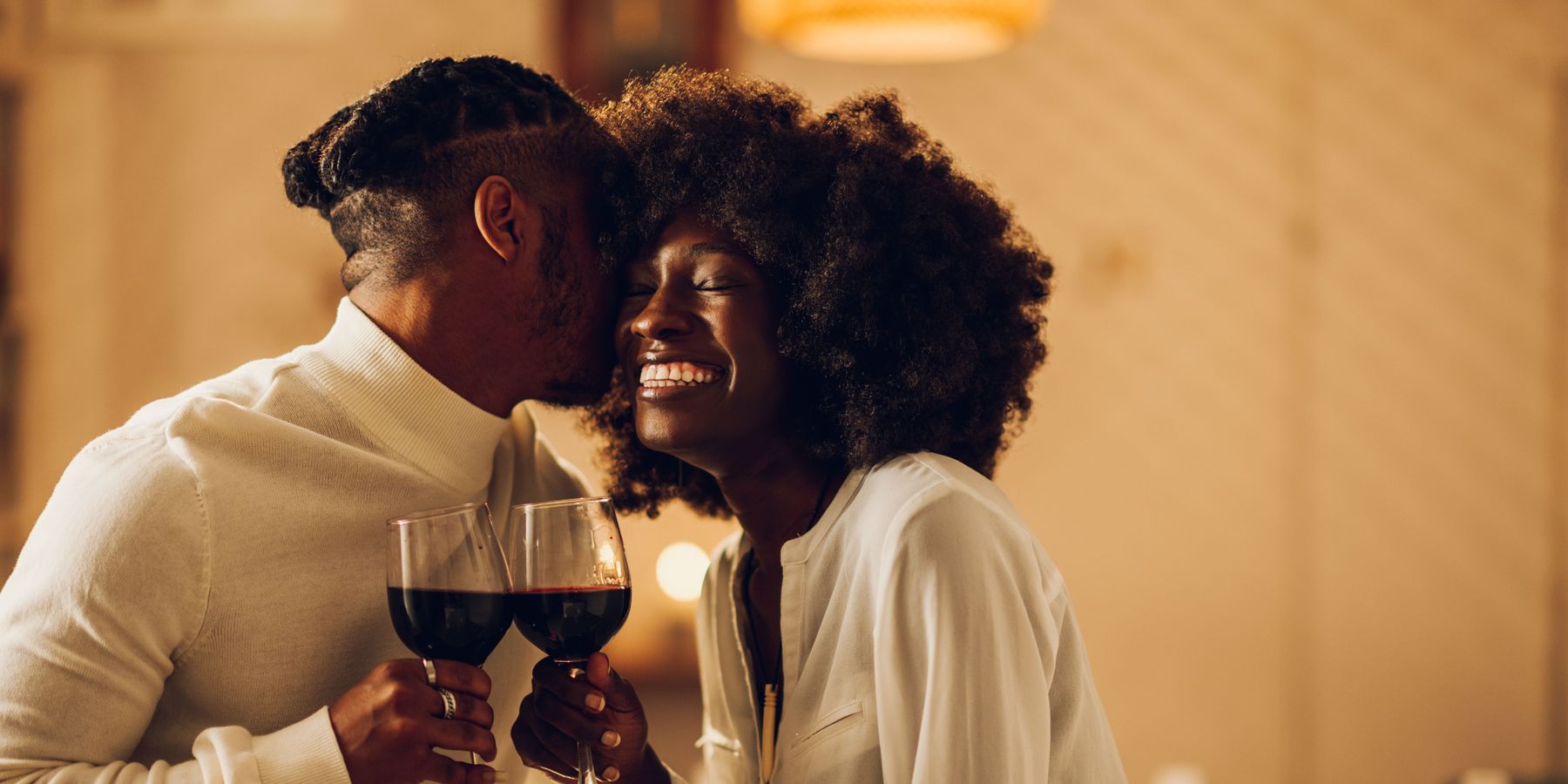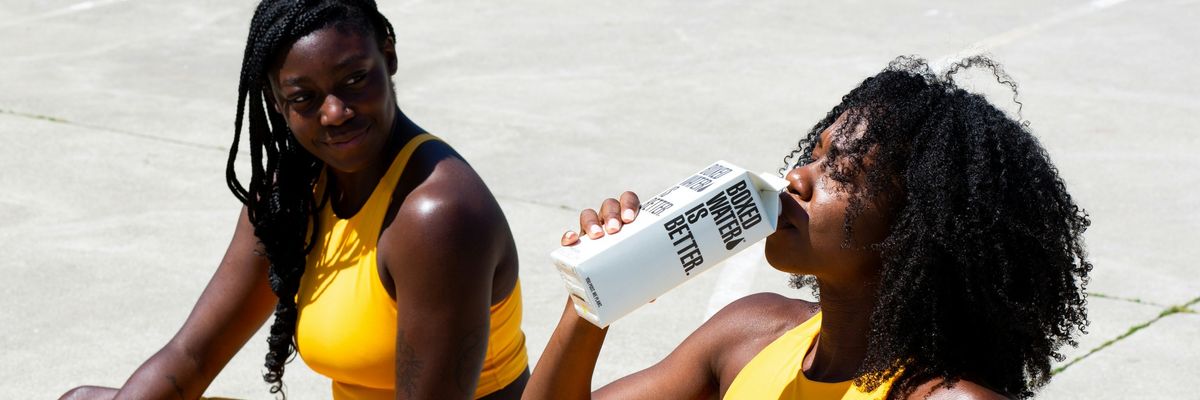
Navigating relationships can be a complex and layered experience. Whether we are in a romantic relationship or developing a friendship, there are so many intricacies and nuances to consider. However, there are ways to dig deeper and connect more intimately with a romantic partner, as well as with yourself. One thing that is unexpected in relationships is what you learn about yourself. Sometimes it is these lessons that give you the greatest insight into your dating patterns.
Besides identifying your love language, it is also important to look into your attachment style, or in other words, how you connect with others. Before we go further, let's get a working definition of attachment styles. According to research conducted by Dr. Cindy Hazan and Dr. Phillip Shaver, attachment is "a biosocial process by which affectional bonds are formed between adult lovers, just as affectional bonds are formed earlier in life between human infants and their parents." So what does this all mean? Basically, how you were raised and how your parents reared you determines how you attach to people in relationships later in life.
This is commonly referred to as the attachment theory.
So why is it important to understand your attachment style in relationships?
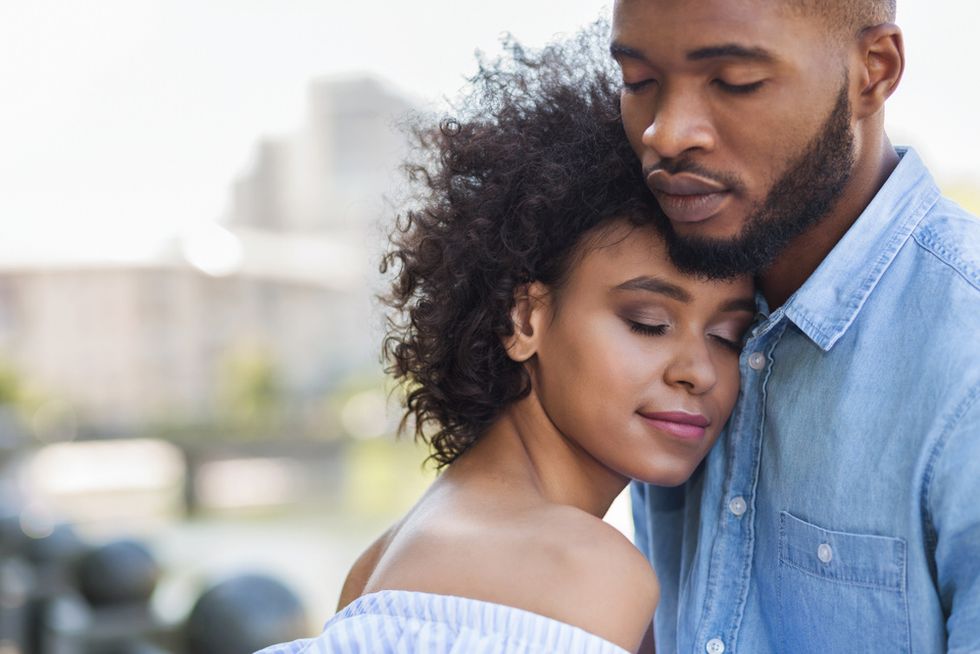
Shutterstock
According to Dr. Ayanna Abrams, a licensed clinical psychologist, "Knowing your attachment style is important because it helps you understand how you organize your world. It helps you to understand how you view yourself in relation to other people and how you tend to view other people in relation to yourself." In close intimates relationships, this is crucial because it can explain why you might push a partner away or why you may cling too closely to people. Depending on which attachment style you lean towards, you can gain insight into the way you bond with people and reveal patterns around dating habits.
There are four attachment styles that can be identified between adults in a relationship: secure, anxious-preoccupied, dismissive-avoidant, and fearful-avoidant.
How you fall into each category depends on a few factors: how you engage and think about closeness and emotional intimacy, how you communicate, how you listen and understand your emotions as well as your partners, your conflict resolution skills, and the expectations you place on your partner or relationships. Each attachment style has a distinct underlying basic characteristic that involves closeness or how comfortable you are being intimate and emotionally close with another person. It also involves a default to dependent/avoidant behavior. Simply put, dependent/avoidant behavior refers to how comfortable you feel depending on people or having people depend on you. Lastly, there is a component of anxiety. This means the amount of fear you have around a partner rejecting or abandoning you.
What are each of the attachment styles?

Shutterstock
Secure Attachment: In this attachment style people are low avoidance and low anxiety. They feel safe in relationships, are comfortable with intimacy, are not worried about rejections, and are not preoccupied with relationships. People in this category tend to be more satisfied with their relationships. As a child, they view their parents as a secure base and feel they can venture out into the world and explore independently. This is also displayed in their adult relationships with a romantic partner where they feel secure and connected while allowing themselves and partner to move freely. They often are able to support their partners when they are troubled. These relationships are honest, open, and equal. Both partners feel independent and loving towards one another. People in this category do not participate in a "Fantasy Bond", this is the belief that connections provide a false sense of security. Couples that fantasy bond do not engage in real acts of love but act in a more robotic, routine way that puts distance between them and actually emotionally relating.
Anxious-Preoccupied: This attachment style is low in avoidance and high in anxiety. People in this category crave closeness and intimacy from their partners but are extremely insecure in their relationships. They are often searching for their partner to rescue or complete them as a person. This can manifest in behaviors that are seeking safety by becoming very clingy but in turn, push away their partner. Even with their desperate and insecure actions, the behaviors more times than none, only serve to exacerbate their own manufactured fears. When they become possessive towards their partners, any independent actions exhibited by their partner may only confirm their fears.

Shutterstock
Dismissive-Avoidant: People who fall into this attachment style are high in avoidance and low in anxiety. They are normally uncomfortable with being close or intimate with other people. They also value their independence and freedom and oftentimes do not worry about their partner's availability. There is a tendency for people in this category to be emotionally distant from their partners. They can appear to be self-centered and only focused on themselves while attending to their own needs. Something else unique to this group is their ability to shut down in emotional situations and turn their feelings off with little to no reaction.
Fearful-Avoidant: This attachment style is high in both avoidance and anxiety. Here, people feel not only uncomfortable with intimacy but worry that their partner is not committed or does not love them. Essentially they feel a state of being afraid of being both too close or too distant from others. They often have trouble keeping their feelings under control, not being able to avoid anxiety but also not being able to run away from their feelings. Unpredictability in their moods is common with fearful-avoidant people. They struggle with wanting to land securely with their partner but also feeling this same person will hurt them. They almost never get their emotional needs met when they are in a relationship.
When you identify what your attachment style is, what's next?
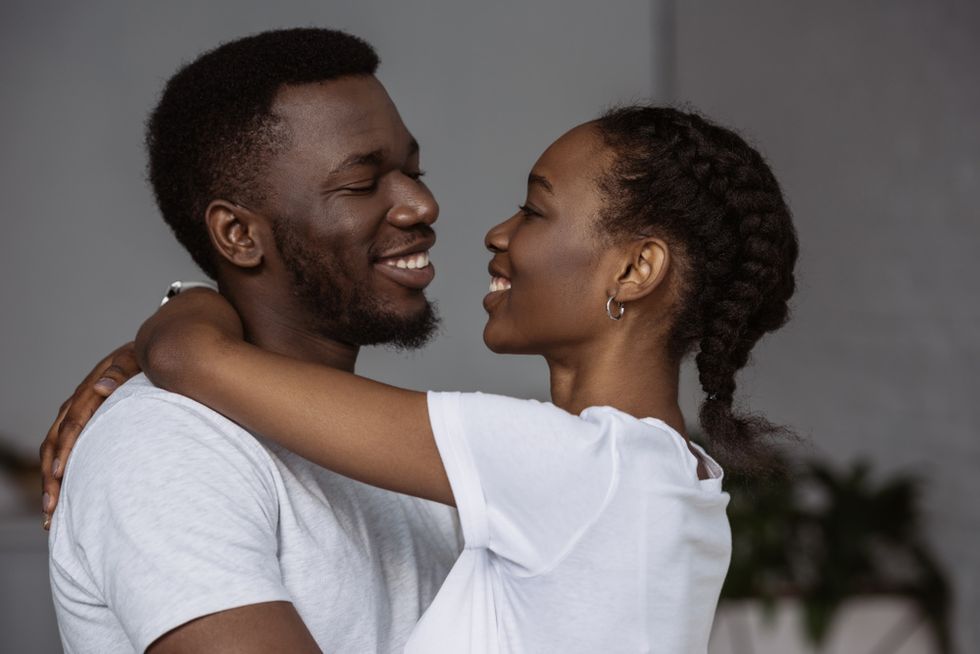 Shutterstock
ShutterstockIf you find that you are securely attached, great! Continue to move forward in this way with people who respect and honor you while still building healthy relationships. However, if you find that you are in an attachment style that is undesirable or not beneficial, can you change your attachment style? The answer is yes. Dr. Niecie Jones, a psychotherapist, suggests doing reflexivity work, or inner reflection, to understand where certain behaviors and patterns may have begun.
Also when doing the work towards changing your attachment style, she adds, "Think of different people in your life, could be mentors, could be friends, who seem to be more open with their boundaries or with their trusting. Find certain things that they are able to say or do as habits that have helped them be more trusting and try to adapt those into your life." So there is hope. If you are thinking about starting this work, look to yourself first.
Where do you go for help to develop a new attachment style?

Shutterstock
There are several types of resources that can help you discover a new attachment style. Ranging from books to actual in-person therapy sessions, there is a wealth of information. For some helpful reading to learn more about how attachment styles affect your love life, check out Hold Me Tight by Dr. Sue Johnson. In it, a therapy called emotionally-focused couple therapy is discussed and how your emotional attachments to your partner are the same as a child to a parent. This book also offers ways to save your relationships by "re-establishing emotional connection," with others.
However, both Dr. Abrams and Dr. Jones agree that help from a professional therapist is ideal in recognizing patterns and developing tools to engage yourself as well as others. Also, if you are in relationships and trying to work through these obstacles, it can be a difficult process. It a good idea to have a professional observe what is going on to identify the attachment styles that may be causing blocks in your romantic partnerships as well as any other relationships you might have in your life. The main key to success in relationships though is both people have to completely invest in the process.
Join our xoTribe, an exclusive community dedicated to YOU and your stories and all things xoNecole. Be a part of a growing community of women from all over the world who come together to uplift, inspire, and inform each other on all things related to the glow up.
Featured image by Shutterstock
- How To Love Without Being Clingy - xoNecole: Women's Interest ... ›
- WTF is a Frozen Five? - xoNecole: Women's Interest, Love, Wellness ... ›
- Turning Fearful Love Into Fearless Love - xoNecole: Women's ... ›
- Shan Boody Dating, Frozen Five - xoNecole: Women's Interest, Love, Wellness, Beauty ›
- Relationship Anxiety & How Anxiety Shows Up In Relationships - xoNecole: Lifestyle, Culture, Love, Wellness ›
This Is How To Keep 'Holiday Season Stress' From Infecting Your Relationship
Hmph. Maybe it’s just me, but it seems like there is something really weird happening in the fall season air (because winter doesn’t officially begin until December 21) that cuddle season is in full swing while break-up season is as well. In fact, did you know that break-ups are so popular during the holiday season that December 11 is deemed Break-Up Day?
The reasons why relationships shift around this time vary; however, I did both roll my eyes and chuckle when I read that a very popular one is because it’s an easy way to get out of getting one’s significant other a Christmas present. SMDH.
Anyway, I personally think that the less shallow folks out here may contemplate calling things “quits” or they at least distance themselves a bit from their partner (and what I’m referring to is serious relationships) due to all of the stress and strain that oftentimes comes with the holidays whether it be financial, familial, due to their tight schedules or something else.
Listen, I would hate for you and your man to miss the fun and happiness of experiencing this time of year, all because you are so overwhelmed or irritated that you can’t really enjoy it. That’s why I have a few practical tips for how to avoid allowing the typical holiday season stress from INFECTING your relationship.
Manage Your Expectations
 Giphy
GiphyUnmanaged expectations. If there is a main reason why the holiday season tends to be so stress-filled for so many people, I’d bet good money that this is the cause. And when you’re in a long-term relationship, expectations can manifest themselves in all sorts of cryptic and/or unexpected ways. You might have relatives who assume that you are going to be with them for Thanksgiving or Christmas when you have other plans in mind. You might be thinking that you are going to spend one amount for presents while your man is thinking something totally different. When it comes to scheduling, your signals may be crossed.
And you know what? To all of these scenarios, this is where clear and consistent communication come in. Don’t assume anything. Don’t dictate anything either. From now until New Year’s, mutually decide to check in once a week, just to make sure that you are both on the same page as it relates to the holidays and what you both are thinking will come along with it. The less blindsided you both feel, the less stressed out you will be. Trust me on this.
Set (and Keep) a Budget
 Giphy
GiphyOkay, so I read that last year, 36 percent of Americans incurred some type of holiday-related debt. Hmph. Last year, there was still some sense of normalcy in this country, chile, so I can only imagine what finances are gonna look like over the next several weeks. That said, since I don’t know a lot of people who don’t find being broke stressful, make sure that you and your bae set a budget and then stick to it this year — no ifs, ands or buts.
Because really, y’all — it doesn’t make sense to deplete savings and/or max out credit cards for a few days of giggles only to be damn near losing your mind because you don’t know how to make ends meet come Dr. Martin Luther King, Jr. Day.
And by the way, this tip doesn’t just speak to things like food and gifts; I also mean travel. If it doesn’t make a ton of sense (or cents) to be all over the place this year — DON’T BE.
Keep Matthew 5:37 at the Forefront
 Giphy
GiphyIf off the top of your head, you don’t know what Matthew 5:37 says, no worries, here ya go: “But let your ‘Yes’ be ‘Yes,’ and your ‘No,’ ‘No.’ For whatever is more than these is from the evil one.” That verse right there? Oh, it’s a boundaries lifesaver! I say that because do you see “maybe” or “I’ll think about it” in there? Nope. LOL. It says that you should tell people “yes” or “no” and leave it at that — and that complements Anne Lamott’s quote, “’No’ is a complete sentence” impeccably well. Yeah, you’ve got to remember that anything beyond a yes or no to a request is privileged information; you don’t owe anyone details or an explanation.
Besides, if you are really honest with yourself, when someone asks you something and you give a “Umm, let me think about it” kind of reply, more times than not, you already know what your answer is going to be — so why not let you both off of the hook? Give your response. Commit to that. And let everyone (including yourself) get on with their lives and schedules.
I promise you that when it comes to those holiday parties, you are pissing more folks off by not RSVP’ing or doing so and not showing up than just saying, “Thank you but not this year” off the rip.
Remember That Your Personal Space Is Privilege Not a Right
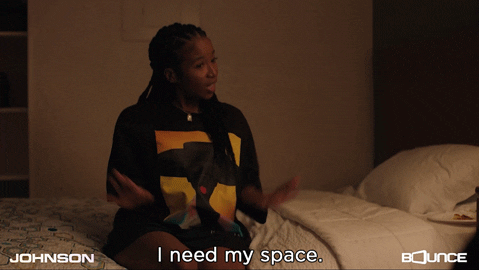 Giphy
GiphyA friend of mine recently bought a new house and invited me over to come see it. He’s a single man with no children, so as I was taking in all of the space that he had, especially as I walked through his finished basement, I joked about relatives coming to live with him. “Hell no” and “absolutely not” were pretty much his immediate responses as he went on to say that some folks even had the nerve to be offended when he told them that he had no intentions on taking DNA in.
Ain’t it wild how people think that your stuff is their right? And yes, that brings me to my next point. Your home is your sanctuary space. If you want to host folks this year — cool. If not, ALSO COOL. Please don’t let folks (family included) guilt you into how they want you to act or even into what they would do if the shoe was on the other foot. You are not them — and as one of my favorite quotes states, “If two people were exactly alike, one of them would be unnecessary.” (A man by the name Larry Dixon said that.)
Hell, my friends? They know that I am good for sending them random things that they need or even want all throughout the year. Coming over to hang out at my pace, though. Uh-uh. Chalk it up to being a card-carrying member of the ambivert club yet I like keeping my living space personal — and I sleep like a baby, each and every night, for feeling that way.
Always remember that your space, your time, your resources, your energy and shoot, yourself period (including your relationship), are all things that are your own. You get to choose how, when and why you want to share them. The holiday season is certainly no exception.
Cultivate Some “You Two Only” Traditions
 Giphy
GiphyIt’s not uncommon for some couples to hit me up after the holiday season to “detox.” Sometimes it’s due to the financial drama (and sometimes trauma) that they experienced. Sometimes it’s because they allowed their relatives (especially in-laws) to get more into their personal business than they should’ve. More than anything, though, it tends to be because they didn’t get enough quality time together and so ended up feeling “disconnected.”
Please don’t let that happen. Listen, I’m not even a holidays kind of woman and yet, I will absolutely sit myself down with some hot chocolate and chocolate chip cookies to enjoy a Hallmark holiday film or two. Aside from the fact that most of them are lighthearted and sweet, I also like that they usually focus on couples loving on each other amidst all of the holiday beauty and ambiance — which is something that all couples should set aside some time to do.
Maybe it’s a vacation. Maybe it’s a staycation. Or maybe it’s my personal favorite, A SEXCATION. Whether it’s for a few days, the weekend or even overnight — don’t you let the holidays go by without setting aside time for you and your man to celebrate one another. Don’t you dare (check out “Are You Ready To Have Some Very Merry 'Christmas Sex'?”).
GET. SOME. REST.
 Giphy
GiphyI once read that 8 out of 10 people get stressed out over the holidays and 3 out of 10 lose sleep during to it — and when you’re stress-filled and sleep-deprived, that can absolutely lead to hypersensitivity, making mountains out of molehills and even not being in the mood for sex.
Your relationship can’t afford to go through any of this, so definitely make sure to prioritize rest. I don’t care how unrealistic it might seem during this time, sleep should never be seen as a luxury; it will always and forever be a great necessity.
That said, try to get no less than six hours of shut-eye in (check out “6 Fascinating Ways Sex And Sleep Definitely Go Hand In Hand”) and even ask your bae to take a nap with you sometimes (check out “Wanna Have Some Next-Level Sex? Take A Nap, Sis.”). Not only will sleep help to restore your mind, body and spirit but, when it’s with your partner, it’s an act of intimacy that can make you both feel super connected, even in the midst of what might feel like chaos.
___
Holiday season stress is real. Still, never give it the permission or power to throw your relationship off. Put you and your man first and let the holidays be what they are gonna be, chile.
Let’s make things inbox official! Sign up for the xoNecole newsletter for love, wellness, career, and exclusive content delivered straight to your inbox.
Featured image by Shutterstock
I wish I enjoyed drinking plain ole’ water. I don’t, though, and, at this point, I doubt that I ever will. It’s not something that I’m proud of or anything, but like I’ve said in other articles on this platform, to me, water is so damn boring; it’s literally like drinking “wet air.”
That doesn’t mean I don’t accept that it’s a “necessary evil” being that we all are made up of so much water and being dehydrated (which is something that a lot of us are) can cause so many health-related issues, including blurred vision, muscle cramps, dried skin, fatigue and even moodiness.
That’s why, over the years, I’ve been intentional about figuring out ways to get more agua into my body without feeling like it’s a chore or something to dread. And now, I want to pass some of those hacks on to you, just in case you happen to totally relate to where I am coming from.
If something that you want to do more of right through here is get extra H2O into your system, here are 10 tips that can absolutely help to make that possible.
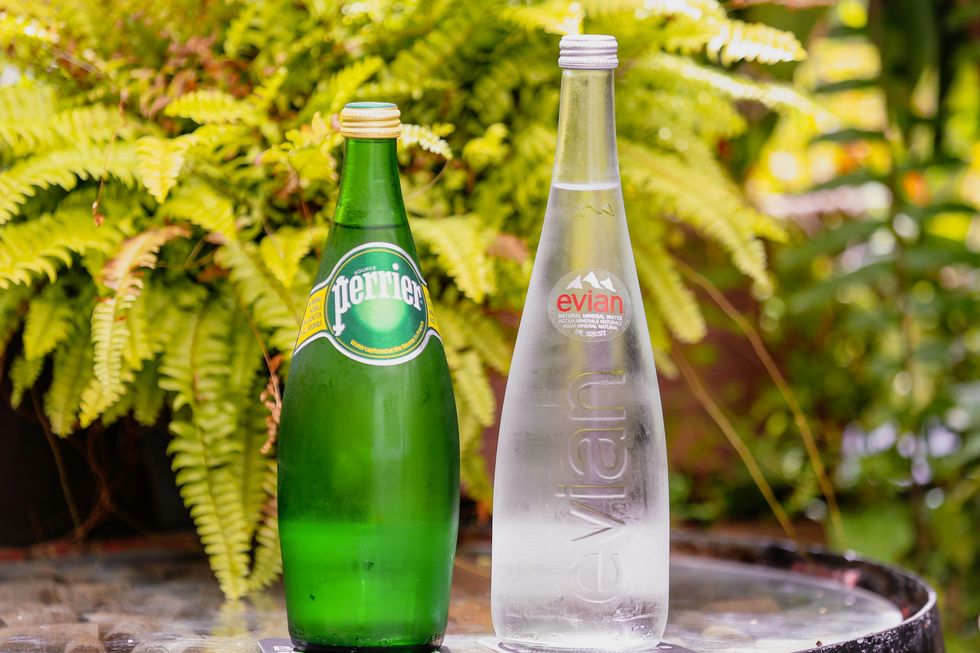
Unsplash
1. Invest in a Fun Water Bottle
There’s a far greater chance that you are going to drink water if you have a water bottle around you. So, cop yourself a cute one — one that will help you to stay motivated. A tumbler that I purchased some time back, just because I thought it was cute as hell, simply says, “Make Better Coochie Decisions” (amen?-LOL). Honestly, that doesn’t just have to apply to sex but how you treat your vagina overall — and that includes making sure that “she” has all of the fluids that she needs.
2. Try Some Sparkling Water or Mineral Water
At this point, I should take stock in Waterloo. It currently is my favorite kind of sparkling water and it has definitely made getting more water into my system easier to do. That’s because I will add some limes to it or a bit of fruit juice to it and that makes drinking water less “meh” for me. Another type of water that has bubbles in it is sparkling mineral water; it can also be beneficial since it contains magnesium, potassium and calcium.

Unsplash
3. Go Halfsies with Your Other Drinks of Choice
Speaking of making some all-natural soda (which is basically what happens when you add juice to sparkling water or sparkling mineral water), you can find yourself drinking more water while consuming less calories if you fill up your glass with half of your favorite fruit juice and half of some sparkling water. More times than not, the juice doesn’t even taste watered down. Try it before you doubt me.
4. Collect Some Infused Water Recipes
I’m forever gonna be a fan of infused water; that’s because it’s water that has fresh fruits and/or veggies in them — and it doesn’t get any healthier than that. Plus, infused water tends to take on the taste of whatever fruits or vegetables that you put into the water (if you let the stuff soak for a couple of hours), so that the water doesn’t taste so boring and bland. Wanna try a few recipes? You can check out some here and here.
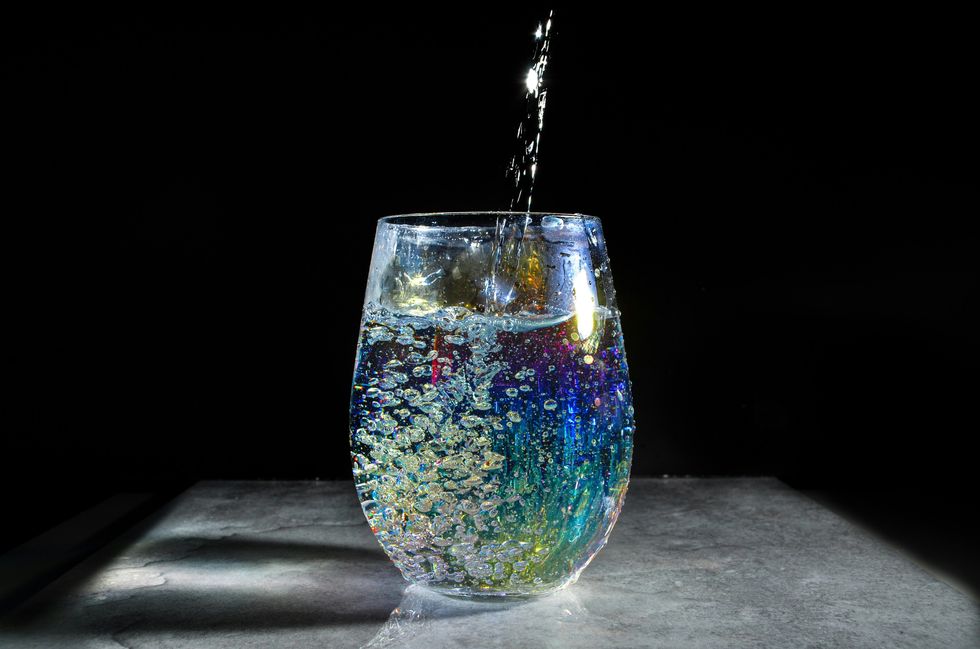
Unsplash
5. Make Slushies Instead of Smoothies
Are you someone who enjoys consuming smoothies? Well, if you want to get more water into your system, how about going with a slushie instead? Although it is true that some smoothies have water as a base, the most bomb ones use milk (or a milk alternative) or yogurt. Slushies, on the other hand, typically go with crushed ice (which is frozen water) instead. That said, some (pardon the pun) cool slushy recipes can be found here, here and here.
6. Use Water As Your “Drink Chaser”
Another great thing about water is it can help to keep you from overeating; it does that by causing you to feel full if you drink it while you are eating. And speaking of calorie-counting, if you don’t want to give up your favorite drink at mealtime, one way to keep from downing 2-3 glasses of it at a time is to use water as your “chaser.” What I mean by that is, after enjoying a glass of your favorite beverage, “chase it down” with a glass of water. That should satisfy your want for what you want without overdoing it.

Unsplash
7. Eat Foods That Are High in Water Content
Another way to get more water into your body is to eat foods that have a ton of water in them. Some that top the list include lettuce (96 percent); cucumber (95 percent); zucchini (95 percent); celery (95 percent); strawberries (91 percent); cantaloupe (90 percent), and peaches (89 percent).
8. Have a Ball with Your Ice Cubes
Ice cubes are frozen water, right? That’s why most of us prefer to enjoy our drinks before the ice cubes melt because melted cubes water down whatever it is that we are consuming. And so, for this very reason, add more ice cubes to your drinks — and have fun making them. You can add juice, fruit and/or mint leaves while making your cubes. That way, they are aesthetically-pleasing; plus, they will also add more flavor to your water once the ice cubes actually melt.

Unsplash
9. Add Some Non-Alcohol Cordial to Your Water
If you’re fine with just having a tad of taste in your water, why not add a bit of cordial to it? Cordial is simply a type of tonic, syrup or sweetener (that can contain alcohol or not) that can help to make your water more…interesting. Some alcohol-based cordials can be found here. Some non-alcoholic recipes are located here.
10. Technically, Herbal Tea Counts
Tea is always gonna be my thing. That’s why I’ve penned articles on it for the site like “10 Different Ways Herbal Teas Can Fit Into Your Beauty Regimen”, “10 'Uncommon' Teas You Should Add To Your Stash (& Why)” and “I've Got 10 Teas That Will Help You To Age (Even More) Gracefully” And y’all, if you want to get a lot more water into your system yet a tall glass of water only isn’t your — pardon the pun — cup of tea, make some iced herbal tea instead.
It’s basically water with some herbs tossed in and, if you add some honey or raw organic coconut palm sugar to it, it will be a really sweet treat that will still be extremely hydrating (and very healthy) for you.
Water that is a bit more exciting for you…now. LOL.
Drink up!
Let’s make things inbox official! Sign up for the xoNecole newsletter for love, wellness, career, and exclusive content delivered straight to your inbox.
Featured image by Unsplash








